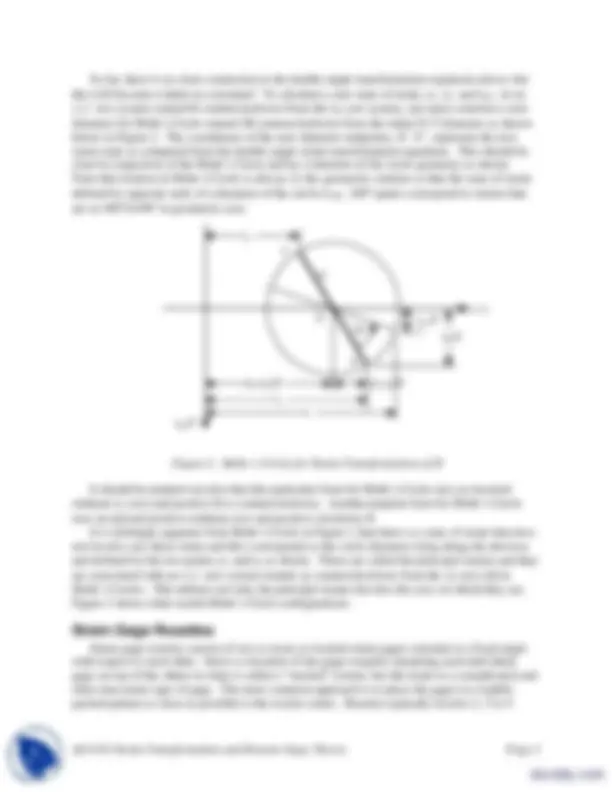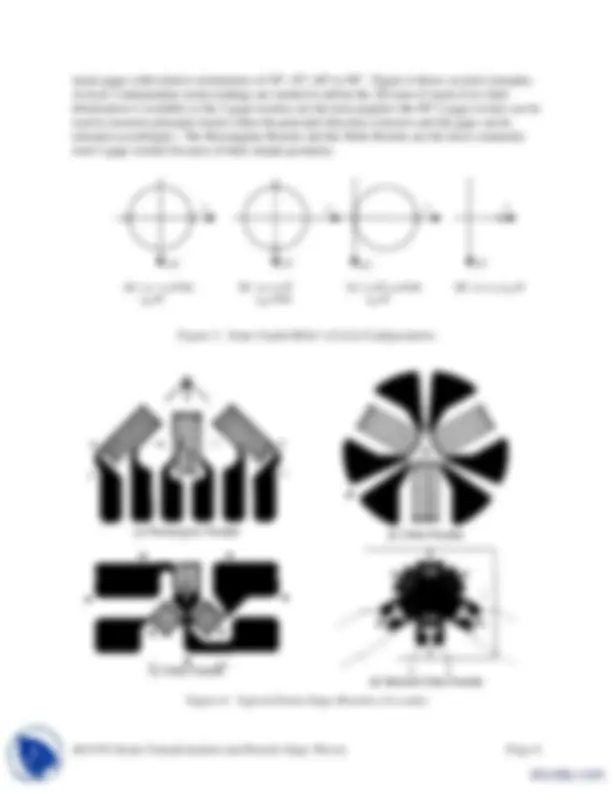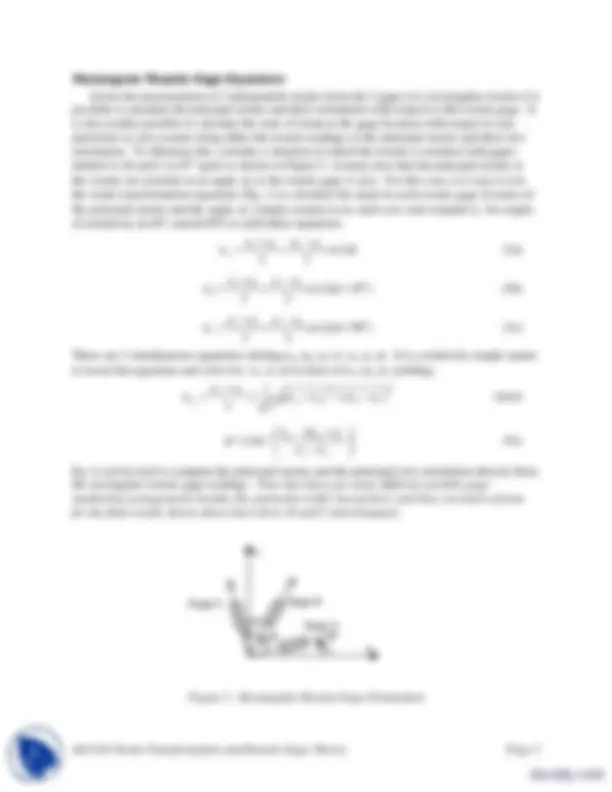





Study with the several resources on Docsity

Earn points by helping other students or get them with a premium plan


Prepare for your exams
Study with the several resources on Docsity

Earn points to download
Earn points by helping other students or get them with a premium plan
Community
Ask the community for help and clear up your study doubts
Discover the best universities in your country according to Docsity users
Free resources
Download our free guides on studying techniques, anxiety management strategies, and thesis advice from Docsity tutors
This is simulation experiment for Mechanics course. It is lab task report which were assigned by Prof. Bhagwan Ramanathan at Alagappa University. Its main points are: Strain, Transformation, Rosette, Guage, Theory, Mohr, Circle, Double-angle, Form, Shear, Orientations
Typology: Exercises
1 / 7

This page cannot be seen from the preview
Don't miss anything!




AE3145 Strain Transformation and Rosette Gage Theory Page 1
It is often desired to measure the full state of strain on the surface of a part, that is to measure not only the two extensional strains, εx and εy, but also the shear strain, γxy, with respect to some given xy axis system. It should be clear from the previous discussion of the electrical resistance strain gage that a single gage is capable only of measuring the extensional strain in the direction that the gage is oriented. Assuming that the x and y axes are specified, it would be possible to mount two gages in the x and y directions, respectively to measure the associated extensional strains in these directions. However, there is no direct way to measure the shear strain, γxy. Nor is it possible to directly measure the principal strains since the principal directions are not generally known. The solution to this problem lies in recognizing that the 2D state of strain at a point (on a surface) is defined by three independent quantities which can be taken as either: (a) εx, εy, and γxy, or (b) ε 1 , ε 2 , and θ, where case (a) refers to strain components with respect to an arbitrary xy axis system, and case (b) refers to the principal strains and their directions. Either case fully defines the state of 2D strain on the surface and can be used to compute strains with respect to any other coordinate system. This situation implies that it should be possible to determine these 3 independent quantities if it is possible to make three independent measurements of strain at a point on the surface. The most obvious approach is to place three strain gages together in a “rosette” with each gage oriented in a different direction and with all of them located as close together as possible to approximate a measurement at a point. As will be shown below, if the three strains and the gage directions are known, it is possible to solve for the principal strains and their directions or equivalently, the state of strain with respect to an arbitrary xy coordinate system. The relations needed are the strain transformation equations and Mohr’s Circle construction provides a good visualization of this process.
The two dimensional strain transformation equations were developed in earlier structural mechanics courses and are very similar to the 2D stress transformation equations (see for example, chapter 6 in, Gere & Timoshenko, Mechanics of Materials, 3rd^ edition, 1990). Without rederivation, they are repeated below:
2 ( )sin cos (cos sin )
sin cos sin cos
cos sin sin cos
2 2
2 2
2 2
′′
′
′
xy y x xy
y x y xy
x x y xy (1)
These transformation equations involve squares and products of sine and cosine functions and these can be replaced with double-angle results to yield the double-angle form of the transformation equations:
AE3145 Strain Transformation and Rosette Gage Theory Page 2
( )sin 2 cos 2
sin 2 2
( ) ( )cos 2
sin 2 2
( ) ( )cos 2
2 1 2 1
2
1 2
1
xy x y xy
xy y x y x y
xy x x y x y
′′
′
′
Given the ready availability of powerful calculators and spreadsheets, evaluation of these transformation equations is a relatively simple matter today and involves little more than a few seconds to enter the formula in a calculator or spreadsheet cell. This was not always so simple a task and the Mohr’s Circle graphical representation was developed long ago to aid in this process. Today, Mohr’s Circle is not needed for graphical calculation, but it does provide a good visualization of the transformation equations and the geometry can be used to infer the actual form for the equations needed for execution in a calculator or computer. The double-angle form of the transformation relations involve simple sine and cosine terms along with a constant that should suggest equations of a circle with center away from the coordinate origin. The trick here is to identify the appropriate new “x” and “y” values to plot to construct a circle. This is perhaps easier to do by explaining the Mohr’s Circle than it is to actually deduce the form directly. Figure 1 below shows Mohr’s Circle for a state of strain defined by an xy axis. Assume for the moment that the coordinates of the opposite ends (X-Y) of the indicated diameter of the circle define the strain state, εx, εy, and γxy, in the xy axis system. Note that both the εx and εy extensional strains are plotted on the abscissa (x axis) while one-half the shear strain, γxy/2, is plotted on the ordinate (y axis). The positive direction for γxy, is taken to be downward (consistent with Gere & Timoshenko). One can construct the circle by first plotting the (εx, γxy/2) pair as point X on the diameter. Next, the pair (εy,-γxy/2) are plotted as the opposite end of the diameter, Y, and the circle can be constructed with X-Y as the diameter. This is the basic Mohr’s Circle and it always has its center on the abscissa at a point given by the value, (εx +εy)/2. The circle diameter is easily computed as: D=sqrt[γxy^2 + (εx-εy)^2 ].
Figure 1. Basic Mohr’s Circle Geometry
εx, εy
γxy /
γxy /
(εx+εy)/2 (εx-εy)/ εx
ε 1
ε 2 εy Y
X
0
D
2φ
AE3145 Strain Transformation and Rosette Gage Theory Page 4
strain gages with relative orientations of 30°, 45°, 60° or 90°. Figure 4 shows several examples. At least 3 independent strain readings are needed to define the 2D state of strain if no other information is available so the 3-gage rosettes are the most popular (the 90° 2-gage rosette can be used to measure principal strains when the principal direction is known and the gage can be oriented accordingly). The Rectangular Rosette and the Delta Rosette are the most commonly used 3-gage rosettes because of their simple geometry.
Figure 3. Some Useful Mohr’s Circle Configurations
(a) Rectangular Rosette (^) (b) Delta Rosette
(c) Delta Rosette (d) Stacked Delta Rosette Figure 4. Typical Strain Gage Rosettes (5x scale)
ε (^) ε ε ε
γ/2 γ/2^ γ/2 γ/
(a) εx= -εy=max γxy=
(b) εx= εy= γxy=max
(c) εx=0; εy =max γxy=
(d) εx= εy; γxy =
AE3145 Strain Transformation and Rosette Gage Theory Page 5
Rectangular Rosette Gage Equations
Given the measurement of 3 independent strains from the 3 gages in a rectangular rosette it is possible to calculate the principal strains and their orientation with respect to the rosette gage. It is also readily possible to calculate the state of strain at the gage location with respect to any particular xy axis system using either the rosette readings or the principal strains and their axis orientation. To illustrate this, consider a situation in which the rosette is oriented with gages labeled A, B and C at 45° apart as shown in Figure 5. Assume also that the principal strains at the rosette are oriented at an angle, φ, to the rosette gage A axis. For this case, it is easy to use the strain transformation equations (Eq. 1) to calculate the strain in each rosette gage in terms of the principal strains and the angle, φ, (simply assume εx=ε 1 and εy=ε 2 and compute εx’ for angles of rotation φ, φ+45º, and φ+90º) to yield three equations:
A (3a)
cos 2 ( 45 ) 2 2
B (3b)
cos 2 ( 90 ) 2 2
C (3c)
These are 3 simultaneous equations relating εA, εB , εC to ε 1 , ε 2 , φ. It is a relatively simple matter to invert the equations and solve for ε 1 , ε 2 , φ in terms of εA, εB , εC yielding:
2 2 1 , 2 ( ) ( ) 2
A C
A B C
21 tan^1 (4c)
Eq. 4 can be used to compute the principal strains and the principal axis orientation directly from the rectangular rosette gage readings. Note that there are many different possible gage numbering arrangements besides the particular A,B,C layout here, and they can lead to forms for the final results shown above but with A, B and C interchanged.)
Figure 5. Rectangular Rosette Gage Orientation
Gage A
Gage C Gage B
ε 1
ε 2
45
45
φ
AE3145 Strain Transformation and Rosette Gage Theory Page 7
gage B axis also bisects the gage A and gage C axes and can therefore also be considered at making an angle of 60° to A and C. As before, it is simply a matter of applying the strain transformation equation from the principal axes to gage A at φ, gage B at φ+60º and gage C at φ+120º, yielding 3 equations in 3 unknowns.
Figure 7. Delta Rosette Gage Orientation
Following a similar approach to that employed for the analysis of the Rectangular Rosette, it is possible to show that the principal strains are given by:
− A B C
C B
A B B C C A
A B C
ε ε ε
ε ε φ
ε ε ε ε ε ε
ε ε ε ε
tan
1 2
1
2 2 2 1 , 2 (5)
Principal Stresses
It should be pointed out that the above results involve strain only and do not describe the state of stress at the rosette. In order to determine the stress state, it is necessary to use the stress- strain relations to express the stress components in terms of the strain components. For linearly elastic (Hookean) behavior, it follows that the principal stresses can be computed from the principal strains (shear strain is zero for this axis system):
2 2 2 1
1 2 1 2
And it should also be noted that for Hookean materials the principal strain and stress directions coincide, so the results for the angle, φ, are unchanged for principal stress directions.
Gage A
Gage C
Gage B
ε 1
ε 2
120
120 φ